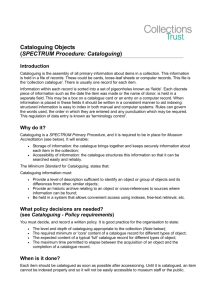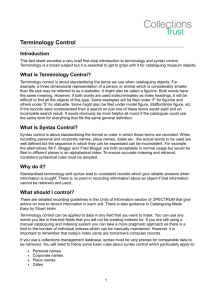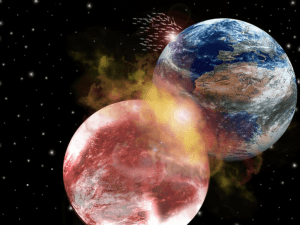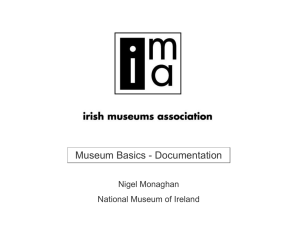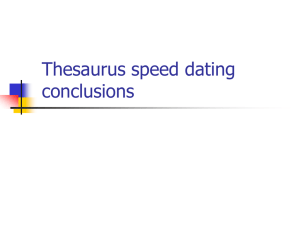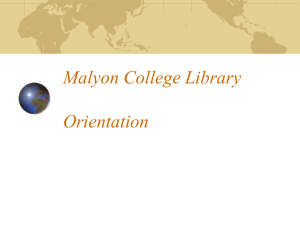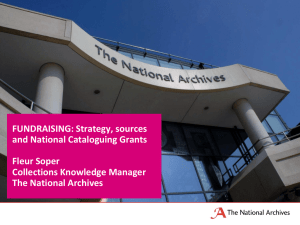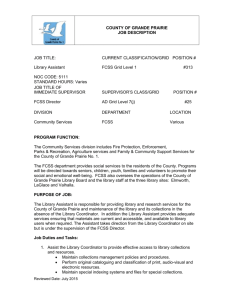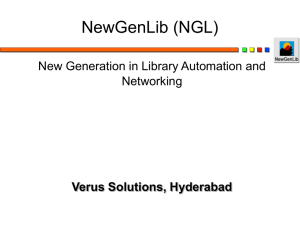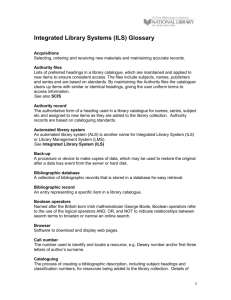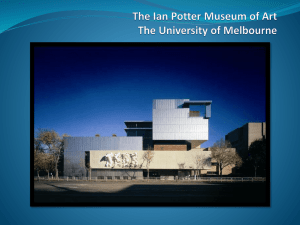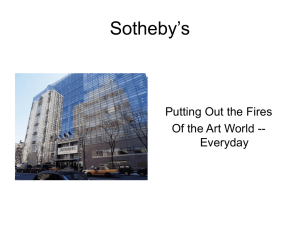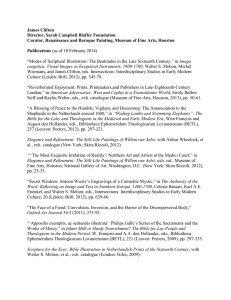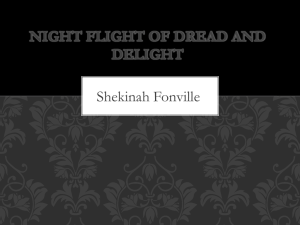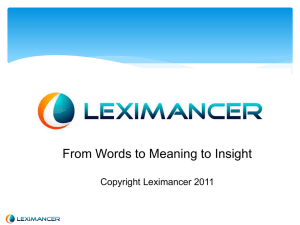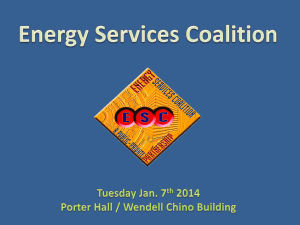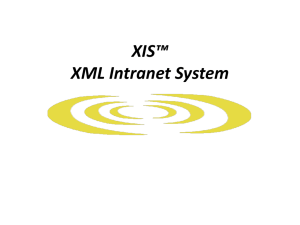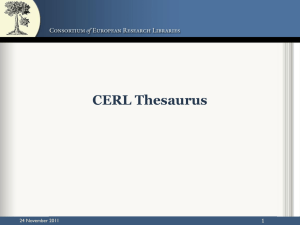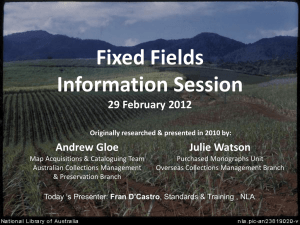Catalogue
advertisement
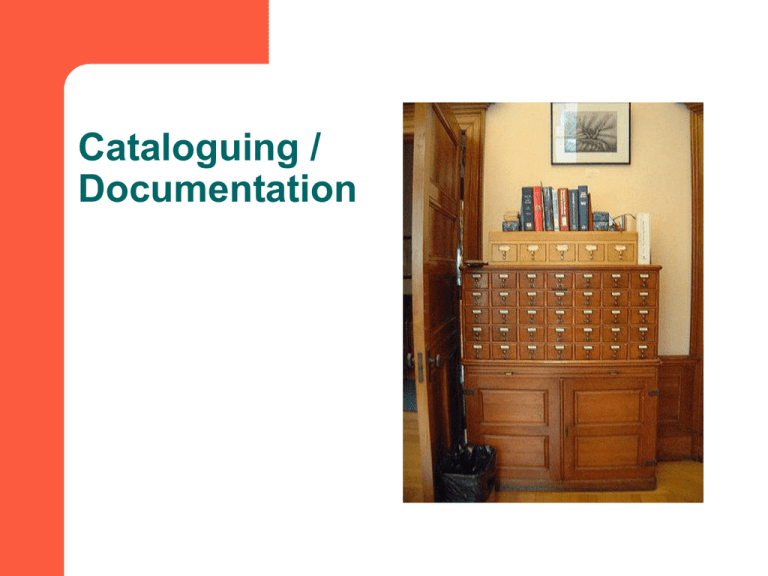
Cataloguing / Documentation Records are the memory of a museum Allow the museum to identify and account for every item in the collection Prove right of ownership together with receipts, Deed of Gift –forms etc Make the difference between an object being an example of a type and the object telling the story of someone’s life Museum Records Some of the types of records created on collection items – – – – Entry records Acquisition register & records Collection catalogue Paper files Collection cataloguing Catalogue brings together and keeps securely information about each item in the collection Catalogue cards Computerised options for small collections – Spreadsheets such as Excel – Database programs such as Access – Collection management systems – PastPerfect – Vernon – E-hive – web-based collections management system – Freeware http://www.impulseadventure.com/photo/flow-catalogcompare.html Advantages of using a database Improves access to collections Improves searchability Enhances knowledge about collections Reports of the collection can be printed out in different formats Can link images/video/audio files Facilitate collections management tasks such as acquisitions, relocations, inventories, loans and exhibitions Data quality The quality of a database is only as good as the quality of information entered Consistency in data entry is important – Ensure that key terms are entered consistently – Cataloguing manual/ data dictionary – improves consistency Controlled dictionaries, authority terms, drop down lists prevent the entry of incorrect or variant data Help in selecting collections management software – Te Papa National Services Guide Deciding on Digital Tools for Collection Management Software suppliers, free trial versions Benefits of good catalogue records Knowing what you’ve got Knowing where things are Knowing if you have lost anything – Providing descriptions of lost or stolen items Helping to answer enquires efficiently Giving researchers access to information about your collections Benefits of good catalogue records Help to look after the objects in your care Help interpretation for exhibitions and education Ensuring the objects stories don’t die with the museum worker Cost of poor documentation Reduces the usefulness of the collection – Do not know what you have – Cannot find objects you have – Duplicates are collected because you don’t know what is in the store rooms – Objects become meaningless because their story has been lost Cost of poor documentation Museum has objects it does not know who they belong to – deaccessioning without having legal title can be risky – stores up problems for the future – ownership wrangles Items are lent out and never returned Thefts go undetected or can not be recovered because of a lack of description of the object Wasted resources Retrospective documentation Clear recent cataloguing backlog – Acquisition information is available Carry out collection inventory – – – – Improve existing catalogue records Deal with catalogued material that has lost the link to documentation – no accession number Deal with unaccessioned material Deal with lost collection items - deaccession Catalogue brings together and keeps securely information about each item in the collection Accession number Name or title Brief description Photograph Production place & year Maker, production technique Materials Measurements Inscriptions History/Provenance Other id Classification Location in your store Cataloguer and date Name/Title Use standard terms for naming objects http://www.collectionstrust.org.uk/spectrumterminology/termbank For artwork use the tile given by artist – If artwork has no title use ‘Untitled’ and in brackets description [View of Blackball] For photographs use a short description eg. Crowd in Cathedral Square, Christchurch, celebrating Armistice Day Group at the 1914 Chess Championship of New Zealand, in Christchurch Brief Description Identify the object from other similar objects Help someone who is reading descriptions to decide if this is an object they want Less need for handling objects What makes this object different from other similar objects ? Brief description Describe what the object looks like Include the objects – – – – – – – – function parts – moving or missing shape materials colour, decoration, texture, patterns, relative size production technique manufacturers marks.labels.brand names/serial numbers Link a photograph to the object record Consistency Develop standards or a style sheet for free text fields such as description For example describing a photograph would you write – World War II – Second World War – World War 2 – World War, 1939 – 1945 Useful for making sure researchers are able to find everything on a subject Inscriptions Write down the inscription itself or description of it – – – Inscriptions are recorded between quote marks with / denoting a new line ‘Made in New Zealand’ / ‘1956’ describe it if it is stamped eg. potters mark Method, type and location of inscription If you are using work sheets or catalogue cards draw the inscription, if you are using a database describe it or take a digital photo Production Data Who made it? Where ? – – When ? – Land Information NZ - NZ place names http://www.linz.govt.nz This can be precise or an approximate date/ period How ? Do you know anything else about the production process or maker? History / Provenance The name, address of the source/donor How you got the object (gift, purchase, bequest) Date when obtained Names and dates of other people who owned or used the object Places and events associated How the object was used ? What did the object mean to the people ? Include any photos of the past owners or any other documentation Donor questionnaires – obtain as much information as you can from previous owner Measurements Take measurement as maximum Use millimeters In order of height x width (length) x depth Textiles use dressmaking measurements Firearms measure the barrel diameter Materials List all materials that the object is composed of What part is made from what Databases have controlled vocabularies to obtain consistency – help in searching Art and Architecture Thesaurus (AAT) Can browse and look up terms online at www.getty.edu/research/conducting_research/ vocabularies/aat/ Condition of the object Condition report is done as part of accessioning process Assess the physical condition of the object = how well preserved the object is Base line to assess whether object has deteriorated over time and how Description of type, extent and location of damage Also possible need for a conservation treatment Other Id Other Id can be a link to entry level documentation - receipt number / deposit record no Old catalogue numbers Temporary numbers Serial numbers for machinery, firearms Location Permanent or usual location Current location Good to have all locations in store room numbered/coded e.g. Collection store/lower/unit 55/bay1/shelf1 Drop down list of locations in your program Important to update location information when object is moved – movement control Credit line Eg. Collection of TheNewDowse Acknowledge the donor Gift of Mr. and Mrs. Smith Classification / indexing Object classification into hierarchical categories – AAT – Art and Architecture Thesaurus by Getty Institute – Nomenclature Subject classification / indexing – What is subject ? what is depicted in a work of art / photograph what is the function of an object TGM II Thesaurus for Graphic Materials – Free download from www.loc.gov/rr/print/tgm2/ – For cataloguing advice see www.loc.gov/rr/print/cataloging.html AAT – Art and Architecture Thesaurus – Can search on-line Terminologies published online by MDA MDA Archaeological Objects Thesaurus MDA Waterways Object Name Thesaurus MDA Railways Object Name Thesaurus British Museum Object Names Thesaurus British Museum Materials Thesaurus ICOM Costume Committee's Vocabulary of Basic Terms Royal Air Force Museum's Aircraft Types Thesaurus http://www.mda.org.uk/ Taxonomic classification Conclusion Be consistent Develop a cataloguing manual Keep all your documentation secure Back up computer files regularly Documentation about your collection is the most precious resource you have Discussion on cataloguing Cataloguing exercise
